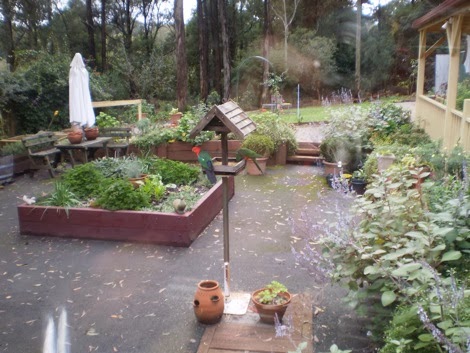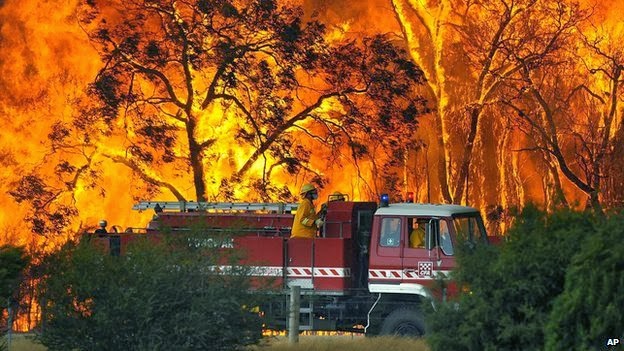Unpredictable March
rain in an Australian garden
Now that March
has arrived, and it is nearing the time that Takis and I will be returning to
the island of Lemnos, we are checking the weather in Lemnos. March is that
uncertain time of the year, in Lemnos as here in Australia. In March, in both
countries, the weather is unpredictable and can turn cold or warming from week to week.
It
is gradually getting colder in Australia and we are no longer on edge, checking the
surrounding countryside for fires. We’ve had a good autumn rain and so we just check the fire monitor now and then,
and it usually only tells us the danger of fire is low to moderate, or perhaps
high, but not severe or extreme any more. However, the garden still needs care
and it can dry out quickly, and I have not stopped watering the pots yet.
In an article written by Jim Carey for BBC he
describes the way the Australian countryside has changed since the coming of
the Europeans, and become more fire-prone with eucalyptus trees taking over sections of the country.
Carey quotes a historian who declares that Aborigines
managed the land differently, by continually clearing and producing grasslands that not only
attracted animals they could hunt but also making massive firebreaks that
preventing the kind of destructive fires we see today.
Jim Carey poses these questions at
the end of his article,
There is an odd tension here,
which rather unusually pitches conservation groups against an ancient
knowledge. What exactly is the "natural" environment of Australia?
He asks if the massive
forests of euclypstus trees, which have proliferated since 1788, are ‘natural or were the pastures gardened by the Aborigines for the tens of thousands of years
prior to that more natural?
Eucalyptus Trees
 Wikipedia has an alphabetical list of 734 Eucalyptus species and 3 hybrids.
Wikipedia has an alphabetical list of 734 Eucalyptus species and 3 hybrids.
The most prolific tree in the Australian bush is the
iconic eucalyptus, nicknamed the 'gum tree' and described by
one fireman as 'a living firebomb'. Carey writes, 'The bark of the tree falls away
in thin flammable sheets - a touch paper to any passing spark - whilst the air
in and around a eucalyptus forest hangs with the oil for which the tree is
renowned. It creates an incendiary haze, which sometimes causes the air to burn
by itself.'
 Eucalyptus tells the story of Ellen Holland, a
young woman whose "speckled beauty" and unattainability become legend
far beyond the rural western New South Wales town near the property where she grows up. Her
protective father's obsession with collecting rare species of Eucalyptus trees leads him to propose a contest - the man
who can correctly name all the species on his property shall win her hand in
marriage. When Mr. Cave arrives, a botanical genius, he appears to be the only
man on earth capable of success. Unfortunately, just as Cave nears his goal, Ellen finds love elsewhere.
Eucalyptus tells the story of Ellen Holland, a
young woman whose "speckled beauty" and unattainability become legend
far beyond the rural western New South Wales town near the property where she grows up. Her
protective father's obsession with collecting rare species of Eucalyptus trees leads him to propose a contest - the man
who can correctly name all the species on his property shall win her hand in
marriage. When Mr. Cave arrives, a botanical genius, he appears to be the only
man on earth capable of success. Unfortunately, just as Cave nears his goal, Ellen finds love elsewhere.
Rain and Thunder Storms: Temperatures
between 11-14 C.
I remember, before I emigrated to Australia, I
once met an Australian who had bought some skis in London to take back with him. I was
amazed, thinking that Australia could not have snowfields. I was wrong. In
the same way, many of my friends and relatives cannot imagine snow, hail and sleet,
in Greece, but I can assure you it gets very cold there too - though not perhaps not as
cold as America has had this winter, but the wind chill on the island can be pretty bad.
This
calendar has a regular (common) year of 365 days divided into 12 months with a
leap day added to the month of February every four years (leap year). This made
the Julian year 365.25 days long on average, and needless to say, this extra
.25 day caused several issues.
Julius
Caesar Augustus
From
Wikipedia
‘Although
all Eastern Orthodox countries (most of them in Eastern or Southeastern Europe) had adopted the Gregorian calendar by 1924,
their national churches had not. The "Revised Julian calendar" was proposed during a synod in Constantinople in May 1923, consisting of a solar part which
was and will be identical to the Gregorian calendar until the year 2800, and a
lunar part which calculated Pascha (Easter) astronomically at Jerusalem. All Orthodox churches refused to accept the
lunar part, so almost all Orthodox churches continue to celebrate Pascha
according to the Julian calendar (with the exception of the Estonian Orthodox
Church and the Finnish Orthodox Church).’
This year
Clean Monday is on the 3rd of March. This is the day that housewives spring
clean, and it marks the first day of Lent.
The weeks of the Great Lent are:
First Sunday (Sunday of Orthodoxy)
Second Sunday (St. Gregory Palamas)
Third Sunday (Adoration of Cross)
Fourth Sunday (St. John of Climax)
Fifth Sunday (St. Mary of Egypt)
Palm
Sunday through Holy Saturday and Easter Sunday
Many Christians in Australia observe Ash Wednesday as the first day of Lent. It is the beginning of the Lenten fast and is the day after Shrove Tuesday, also known as Pancake Tuesday or Pancake Day. I will make pancakes for breakfast tomorrow, not for any religious reason but because it reminds me of my English family's traditions.











No comments:
Post a Comment